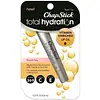What's inside
What's inside
 Key Ingredients
Key Ingredients

 Benefits
Benefits

 Concerns
Concerns

 Ingredients Side-by-side
Ingredients Side-by-side

Octyldodecanol
EmollientRicinus Communis Seed Oil
MaskingEthylcellulose
Caprylic/Capric Triglyceride
MaskingPhenoxyethanol
PreservativePolyglyceryl-3 Diisostearate
EmulsifyingAroma
Linum Usitatissimum Seed Oil
PerfumingOlea Europaea Fruit Oil
MaskingRibes Nigrum Seed Oil
EmollientHelianthus Annuus Seed Oil
EmollientTocopherol
AntioxidantEthylhexylglycerin
Skin ConditioningAscorbyl Palmitate
AntioxidantWater
Skin ConditioningGlycine Soja Oil
EmollientBixa Orellana Seed Oil
EmollientCitrus Grandis Peel Extract
AstringentOctyldodecanol, Ricinus Communis Seed Oil, Ethylcellulose, Caprylic/Capric Triglyceride, Phenoxyethanol, Polyglyceryl-3 Diisostearate, Aroma, Linum Usitatissimum Seed Oil, Olea Europaea Fruit Oil, Ribes Nigrum Seed Oil, Helianthus Annuus Seed Oil, Tocopherol, Ethylhexylglycerin, Ascorbyl Palmitate, Water, Glycine Soja Oil, Bixa Orellana Seed Oil, Citrus Grandis Peel Extract
Petrolatum
EmollientBis-Diglyceryl Polyacyladipate-2
EmollientC12-15 Alkyl Benzoate
AntimicrobialHydrogenated Microcrystalline Wax
Emulsion StabilisingC18-38 Alkyl Hydroxystearoyl Stearate
EmollientCaprylic/Capric Triglyceride
MaskingLinum Usitatissimum Seed Oil
PerfumingOenothera Biennis Oil
EmollientOlea Europaea Fruit Oil
MaskingAroma
Tocopherol
AntioxidantAscorbyl Palmitate
AntioxidantTriacetin
AntimicrobialPropylene Glycol
HumectantGlycine Soja Oil
EmollientCitric Acid
BufferingPetrolatum, Bis-Diglyceryl Polyacyladipate-2, C12-15 Alkyl Benzoate, Hydrogenated Microcrystalline Wax, C18-38 Alkyl Hydroxystearoyl Stearate, Caprylic/Capric Triglyceride, Linum Usitatissimum Seed Oil, Oenothera Biennis Oil, Olea Europaea Fruit Oil, Aroma, Tocopherol, Ascorbyl Palmitate, Triacetin, Propylene Glycol, Glycine Soja Oil, Citric Acid
 Reviews
Reviews

Ingredients Explained
These ingredients are found in both products.
Ingredients higher up in an ingredient list are typically present in a larger amount.
Aroma refers to an ingredient, or mixture of ingredients, that impart or mask a flavor.
The name is slightly confusing. This is because INCI associates aroma with flavor instead of smell.
Here is the official definition from the The International Cosmetic Ingredient Dictionary and Handbook:
“Aroma is a term for ingredient labeling used to identify that a product contains a material or combination of materials normally added to a cosmetic to produce or to mask a particular flavor.”
INCI shows the only purpose of aroma to be "flavouring".
However, due to regulation differences, some companies may use aroma in place of parfum.
In Canada, this ingredient only has to be listed in concentrations above 1%.
Learn more about AromaAscorbyl Palmitate is created by combining pure Vitamin C and palmitic acid. It is an antioxidant and helps reduce hyperpigmentation.
This ingredient is a more stable version of Vitamin C, meaning it does not disintegrate as quickly when exposed to sunlight. However, studies show it does not penetrate skin as well as pure Vitamin C.
Ascorbyl Palmitate is oil soluble.
Read more about other types of Vitamin C:
Learn more about Ascorbyl PalmitateThis ingredient is an emollient, solvent, and texture enhancer. It is considered a skin-softener by helping the skin prevent moisture loss.
It helps thicken a product's formula and makes it easier to spread by dissolving clumping compounds.
Caprylic Triglyceride is made by combining glycerin with coconut oil, forming a clear liquid.
While there is an assumption Caprylic Triglyceride can clog pores due to it being derived from coconut oil, there is no research supporting this.
Learn more about Caprylic/Capric TriglycerideGlycine Soja Oil comes from the soybean. Glycine Soja is native to eastern Asia.
Soybean oil is an emollient. It is rich in antioxidants and fatty acids including palmitic, stearic, oleic, and linoleic acids.
As an emollient, the fatty acids in soybean oil helps keep your skin soft and hydrated. It does so by creating a film on top that traps moisture in.
Soybean oil is also rich in vitamin E, a potent antioxidant. Vitamin E is also anti-inflammatory and provides a soothing effect.
Studies show soy may help fade hyperpigmentation from UVB. It does so by disrupting the melanin process from UVB induced skin inflammation.
This ingredient may not be malassezia folliculitis, or fungal-acne, safe.
Soybeans are rich in proteins and are part of the legume family. Foods made with soybeans include tofu, soymilk, edamame, miso, and soy sauce.
Learn more about Glycine Soja OilLinum Usitatissimum Seed Oil is the expressed oil from the dried ripe seed of the Linseed, Linum usitatissimum L., Linaceae
Olea Europaea Fruit Oil is the fixed oil obtained from the ripe fruit of the Olive. In other words - olive oil.
The primary contents of olive oil are glycerides of the fatty acids linoleic, oleic and palmitic.
Olive oil also contains antioxidants such as Vitamin E. Antioxidants may help reduce signs of aging by fighting unstable free-radical molecules. It also contains Vitamins A (retinol), D, and K.
The squalene in olive oil makes it a great emollient. Emollients help soothe and soften your skin by trapping moisture in. This makes olive oil a great skin moisturizer.
Studies show olive oil to have antibacterial and antifungal properties in low concentrations. Another study found olive oil irritated sensitive oily skin. We always recommend speaking with a professional about using this ingredient in your routine.
Due to the fatty acid content, this ingredient may not be fungal-acne safe.
Learn more about Olea Europaea Fruit OilTocopherol (also known as Vitamin E) is a common antioxidant used to help protect the skin from free-radicals and strengthen the skin barrier. It's also fat soluble - this means our skin is great at absorbing it.
Vitamin E also helps keep your natural skin lipids healthy. Your lipid skin barrier naturally consists of lipids, ceramides, and fatty acids. Vitamin E offers extra protection for your skin’s lipid barrier, keeping your skin healthy and nourished.
Another benefit is a bit of UV protection. Vitamin E helps reduce the damage caused by UVB rays. (It should not replace your sunscreen). Combining it with Vitamin C can decrease sunburned cells and hyperpigmentation after UV exposure.
You might have noticed Vitamin E + C often paired together. This is because it is great at stabilizing Vitamin C. Using the two together helps increase the effectiveness of both ingredients.
There are often claims that Vitamin E can reduce/prevent scarring, but these claims haven't been confirmed by scientific research.
Learn more about Tocopherol